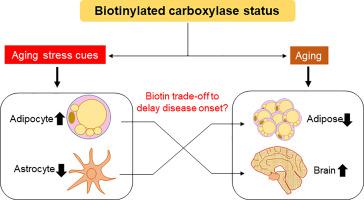当前位置:
X-MOL 学术
›
Nutr. Res.
›
论文详情
Our official English website, www.x-mol.net, welcomes your feedback! (Note: you will need to create a separate account there.)
Distinct utilization of biotin in and between adipose and brain during aging is associated with lipogenic shift in Wistar rat brain
Nutrition Research ( IF 4.5 ) Pub Date : 2020-07-01 , DOI: 10.1016/j.nutres.2020.06.004 Ramaian Santhaseela Anand 1 , Dhasarathan Ganesan 1 , Senthilraja Selvam 1 , Sudarshana Rajasekaran 1 , Tamilselvan Jayavelu 1
Nutrition Research ( IF 4.5 ) Pub Date : 2020-07-01 , DOI: 10.1016/j.nutres.2020.06.004 Ramaian Santhaseela Anand 1 , Dhasarathan Ganesan 1 , Senthilraja Selvam 1 , Sudarshana Rajasekaran 1 , Tamilselvan Jayavelu 1
Affiliation

|
Tissue-specific metabolism determines their functions that collectively sense and respond to numerous stress cues to achieve systemic homeostasis. Chronic stress skews such metabolic profiles and leads to failure of organs as evidenced by a bias towards lipid synthesis and storage in the aging brain, muscle, and liver under Alzheimer's disease, sarcopenia, and non-alcoholic fatty liver disease, respectively. In contrast, the tissue destined for lipid synthesis and storage, such as adipose, limits its threshold and develops diabetes mellitus. However, the underlying factors that contribute to this lipogenic shift between organs are unknown. From this perspective, differential biotin utilization between lipid-rich tissues such as adipose and brain during aging was hypothesized owing to the established role of biotin in lipogenesis. The same was tested using young and aged Wistar rats. We found that adipose-specific biotin content was much higher than the brain irrespective of aging status, as well as its associated cues. However, within tissues, the adipose fails to maintain its biotinylation levels during aging whereas the brain seizes more biotin and exhibits lipid accumulation. Furthermore, mimicking the age-related stress cues in vitro such as high glucose and endoplasmic reticulum stress deprive the astroglial biotin content, but not that of adipocytes. Lipid accumulation in the aging brain was also correlated with increased S-adenosylmethionine levels and biotin utilization by astrocytes. In summary, differential biotin utilization between adipose and brain under aging and their respective cell types like adipocytes and astrocytes under age-associated stress cues connects well with the lipogenic shift in rat brain.
中文翻译:

衰老过程中脂肪和大脑中生物素的不同利用与 Wistar 大鼠大脑的脂肪生成转变有关
组织特异性代谢决定了它们的功能,这些功能共同感知并响应众多压力线索以实现系统稳态。慢性压力会扭曲这种代谢特征并导致器官衰竭,这可以通过分别在阿尔茨海默病、肌肉减少症和非酒精性脂肪性肝病下老化的大脑、肌肉和肝脏中脂质合成和储存的偏见来证明。相比之下,用于脂质合成和储存的组织,如脂肪,会限制其阈值并发展为糖尿病。然而,导致器官间脂肪生成转变的潜在因素尚不清楚。从这个角度来看,由于生物素在脂肪生成中的既定作用,假设在衰老过程中富含脂质的组织(如脂肪和大脑)之间的生物素利用不同。使用年轻和年老的 Wistar 大鼠进行了相同的测试。我们发现,无论衰老状态及其相关线索如何,脂肪特异性生物素含量都远高于大脑。然而,在组织内,脂肪在衰老过程中无法保持其生物素化水平,而大脑会捕获更多的生物素并表现出脂质积累。此外,在体外模拟与年龄相关的压力线索,如高糖和内质网压力,会剥夺星形胶质细胞生物素的含量,但不会剥夺脂肪细胞的生物素含量。衰老大脑中的脂质积累也与 S-腺苷甲硫氨酸水平增加和星形胶质细胞对生物素的利用有关。总之,
更新日期:2020-07-01
中文翻译:

衰老过程中脂肪和大脑中生物素的不同利用与 Wistar 大鼠大脑的脂肪生成转变有关
组织特异性代谢决定了它们的功能,这些功能共同感知并响应众多压力线索以实现系统稳态。慢性压力会扭曲这种代谢特征并导致器官衰竭,这可以通过分别在阿尔茨海默病、肌肉减少症和非酒精性脂肪性肝病下老化的大脑、肌肉和肝脏中脂质合成和储存的偏见来证明。相比之下,用于脂质合成和储存的组织,如脂肪,会限制其阈值并发展为糖尿病。然而,导致器官间脂肪生成转变的潜在因素尚不清楚。从这个角度来看,由于生物素在脂肪生成中的既定作用,假设在衰老过程中富含脂质的组织(如脂肪和大脑)之间的生物素利用不同。使用年轻和年老的 Wistar 大鼠进行了相同的测试。我们发现,无论衰老状态及其相关线索如何,脂肪特异性生物素含量都远高于大脑。然而,在组织内,脂肪在衰老过程中无法保持其生物素化水平,而大脑会捕获更多的生物素并表现出脂质积累。此外,在体外模拟与年龄相关的压力线索,如高糖和内质网压力,会剥夺星形胶质细胞生物素的含量,但不会剥夺脂肪细胞的生物素含量。衰老大脑中的脂质积累也与 S-腺苷甲硫氨酸水平增加和星形胶质细胞对生物素的利用有关。总之,



























 京公网安备 11010802027423号
京公网安备 11010802027423号